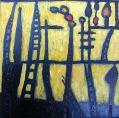|
Using My LaTeX and/or LyX files.
|
 |
|
Using My LaTeX and/or LyX files.
|
 |
On the other hand, you may like the PDF files I've provided, and simply want to print them in an efficient way. The most satisfactory approach in my view is to print the 5.5"x8.5" pages so that 4 of them fit on a single letter-size sheet of paper -- two on the front and two on the back. There are several approaches to this. One correspondent, Rick Holbert, has informed me of a way of doing this within LyX itself. Details on this aproach will be presented shortly. You might want to take a look at Rick's website , if you are interested in binding the books you print.
Another approach is to post-process the PDF, creating Postscript with the pages rearranged appropriately. Here's a way to do that, using the so-called PSUTILS programs available on most Linux systems:
# As an example, use the file jjclk10.pdf.These steps produce a stack of paper which, if sliced down the middle with a paper cutter, give you all of the pages in the correct order. If you want to fold the paper instead of cutting it, you'll need to produce smaller sized "signatures" in the psbook-step above. This, sadly, must be left as an exercise for the reader.# Convert PDF to Postscript
pdftops -paperw 396 -paperh 612 jjclk10.pdf# Rearrange the pages into booklet form.
psbook -q jjclk10.ps temp1.ps# Convert to 2-up
psnup -2 -pletter -W396 -H612 -q temp1.ps temp2.ps# Sadly, there is currently a bug in PSUTILS so that
# the output file still thinks it's 5.5"x8.5". So,
# manually edit temp2.ps with a text editor, changing
# the line that reads
# %%DocumentMedia: plain 396 612 0 () ()
# to
# %%DocumentMedia: plain 612 792 0 () ()# Pull off the odd-numbered 2-up pages, in reverse order.
psselect -o -r temp2.ps frontsides.ps# Pull off the even-numbered 2-up pages, in normal order.
psselect -e temp2.ps backsides.ps# This step prints the fronts:
lpr frontsides.ps... put the pages just printed back in the paper tray ...
# This step prints the backs:
lpr backsides.ps